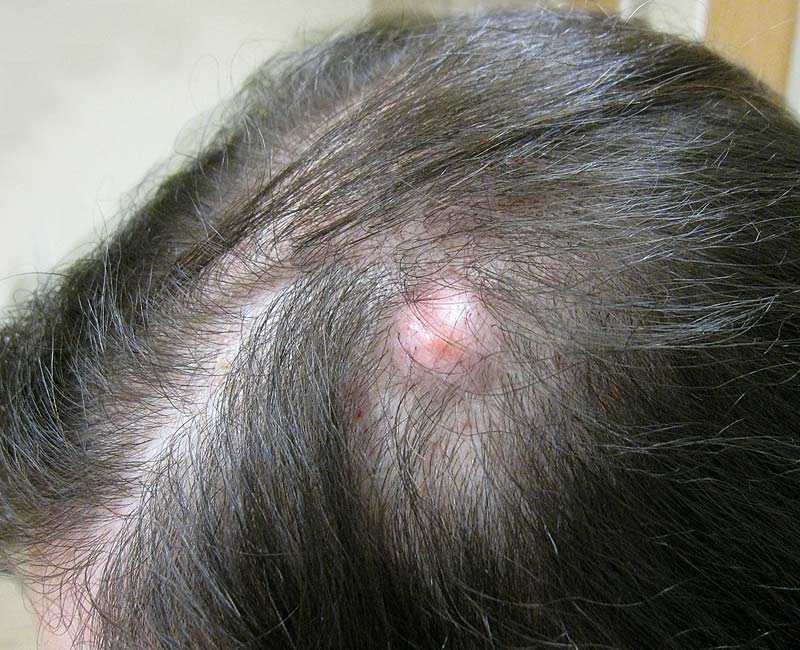Pilar cysts are relatively rare benign cysts that grow from your hair follicles. Most pilar cysts surface on your scalp (head), but they can appear on your face, neck, arms and legs. Pilar cysts are sometimes called trichilemmal cysts or wens. Healthcare providers use surgery to remove cysts.
Advertisement
Cleveland Clinic is a non-profit academic medical center. Advertising on our site helps support our mission. We do not endorse non-Cleveland Clinic products or services. Policy

Pilar cysts are relatively rare noncancerous (benign) cysts that grow from your hair follicles. Most pilar (pronounced pīlər) cysts surface on your scalp (head), but they can appear on your face, neck, arms and legs. Pilar cysts are sometimes called trichilemmal cysts or wens. Trichilemmal (trĭk-e-lemmal) cysts usually don’t hurt. They can become painful if they rupture on their own, you’ve tried to pop them or they start to press down on your skull. Healthcare providers use surgery to remove cysts.
Advertisement
Cleveland Clinic is a non-profit academic medical center. Advertising on our site helps support our mission. We do not endorse non-Cleveland Clinic products or services. Policy
Pilar cysts affect about 10% of the population. Women are more likely than men to develop trichilemmal cysts.
A pilar cyst may feel like a smooth, flesh-colored lump on your scalp that you first notice while washing or combing your hair. Trichilemmal cysts can crop up anywhere on your body, but you’ll usually find them on your scalp, face and neck. If you have one cyst, more may develop.
Pilar cysts grow slowly, so you may not notice one right away. But they can grow to be quite large — sometimes as large as a baseball. While these cysts are benign and don’t hurt, having a large cyst may make you feel self-conscious about your appearance.
For the most part, trichilemmal cysts are benign, meaning they don’t become cancerous. About 3% of all trichilemmal cysts become proliferating trichilemmal tumors (PTTs). They’re called proliferating tumors because they grow quickly, unlike slow-growing pilar cysts. Like pilar cysts, healthcare providers treat PTTs by removing them.
People frequently confuse sebaceous cysts and pilar cysts, but there are several differences between the two:
Advertisement
Pilar cysts happen when old skin cells and keratin begin to pile up under the surface of your skin. Your skin is constantly creating new skin cells and getting rid of old ones. Usually old skin cells stop multiplying and fall off your skin’s surface. But sometimes they get trapped under your skin’s epidermis, or top layer, where they keep on multiplying. At the same time, your scalp is creating keratin, a protein that makes skin, hair and nail cells. Your old skin cells and your keratin cells combine to create layer after layer of cells. Over time, and many layers later, your old skin cells and keratin cells become pilar cysts. These cysts push up your outer skin, which is when you may begin to notice the cysts.
Pilar cysts are hereditary, meaning you may inherit a tendency to develop these cysts.
Trichilemmal cysts are flesh-colored nodules or lumps that usually appear on your head. They can surface on your face, neck, arms and legs. You may not notice these cysts unless they grow large enough for you to feel them or see them or they rupture.
Healthcare providers typically diagnose pilar cysts by examining your scalp. In some cases, they may order computed tomography (CT) scans or magnetic resonance imaging (MRI) scans to check your cyst’s growth or to see if it has grown into the bones of your head.
Healthcare providers typically use surgery to remove trichilemmal cysts. They may need to shave your head so they can remove your cysts. Once they’ve removed the cysts, they’ll close the surgery sites with stitches. They may examine the cysts under a microscope to confirm your cysts aren’t cancerous.
Like any surgery, your surgery site can become infected. Your healthcare provider will tell you how to keep your surgery site clean and how to protect it against infection.
You may need more than one surgery to remove all of your pilar cysts. These cysts can come back, so you may need to monitor for new cysts.
Pilar cysts are hereditary conditions, meaning you're likely to develop these cysts if other family members have cysts. If your family medical history includes trichilemmal cysts, ask your healthcare provider what you can do to monitor for pilar cysts.
The most important thing you can do is rely on your healthcare provider to remove your trichilemmal cysts. You may end up with an infection if you try to pop or slice open your cysts. Cysts can also rupture on their own. If that happens, you should put a gauze pad on the ruptured cyst and contact your provider.
You should contact your provider if you notice lumps on your head that may be cysts. If you’ve had cysts removed, you should keep an eye on your scalp and talk to your provider if you notice new lumps.
Advertisement
You should go to the emergency room if you have a ruptured cyst or you think your cyst surgery site is infected. Signs of infection are:
Pilar cysts are rare benign cysts that usually surface on your scalp. You may have questions about living with pilar cysts. You may want to ask your healthcare provider:
Pilar cysts may be more of a nuisance than a medical problem. But these cysts can become problematic if they grow large enough to make you feel uncomfortable or self-conscious or if they rupture. Trichilemmal cysts are hereditary. If pilar cysts run in your family, ask your healthcare provider how to watch for cysts and when it may make sense to have surgery to remove them.
Advertisement
Every day, people see your skin, hair and nails. At Cleveland Clinic, our expert and caring dermatology team will make sure they’re healthy and strong.

Last reviewed on 05/24/2022.
Learn more about the Health Library and our editorial process.